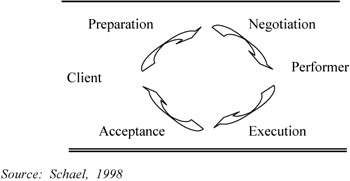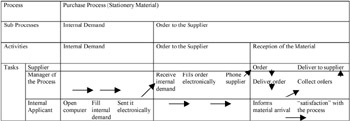Case Study
|
|
Data Collection and Analysis
This framework was applied to a Portuguese company that implemented a WS. This was a longitudinal study, where I accompanied the enterprise from initial implementation of the system, until some nine months following its full operation.
Data collection was done between May 1999 and March 2001. I used multiple techniques to gather data and collected several documents about the enterprise, including the process where the WS was going to be implemented. I observed meetings and training classes, as well as people at work. I also conducted more than 20 semi-structured interviews, each about half an hour in length, with some participants being interviewed more than once over the period of study. The interviews were done at three different stages. The first occurred before the adoption of the system. The purpose of these interviews was to know how people worked, their vision of the enterprise and their expectations regarding the system. The second and third stages occurred after one month and between six and nine months, respectively, of the installation of the system. The objective of these interviews was to know what kind of changes people had identified and the reasons behind these changes.
The interviews spanned all levels of the company and all the potential users of the system. They were fully recorded and transcribed. I used qualitative techniques to analyse data (Miles & Huberman, 1994), and whenever necessary used the NUD*IST [2] program.
The Organization
Fieldwork was conducted with the Alpha Corporation (pseudonym). This organization was incorporated in December 1985 and is located in the north of Portugal. In the early days, the business was mostly concerned with the microfilming of hospital radiological images. Later, in 1996, the company re-oriented to consulting and programming activities in Electronic Documentation Storage. In 1998, the company developed a Document and Database Filing System, which is part of a proprietary Electronic Document Management System (EDMS). Although it started as a family business, this company currently employs 45 workers, whose average age is 28 years old. The staff is now distributed in a linear and functional hierarchical structure with three levels that comprise the following departments: administrative and financial (AFD), commercial, quality, research and development (R&D), marketing, SAP, technical support and production. This growth was due to increased market demand in the area of microfilming and digital archive and also to the development and success of their EDM System.
In 1999, for strategic reasons, Alpha Corporation decided to adopt a WS. Their objectives were to understand the process of development and implementation of this system. Such knowledge would help them to incorporate it into their EDMS and to maintain (and possibly increase) their market share. They also needed this to comply with the requirements of Quality Process Certification.
Each department has only one or two employees, except production, which has more than half of the employees of the firm. The top of the hierarchy is composed of three partners to whom all the departments report.
In technological terms, the company is well-equipped. There is almost one computer per person. Employees are familiar with technology and are confident in the use of their equipment.
As for human factors, almost all the employees have a college degree, except two members: one from AFD, who has completed secondary school, and the production director, who has a ninth-grade education. Both will be the members of staff who will use the new system most regularly. Everyone does regular training in his or her field of work. Generally speaking, the employees of this firm are interested, committed and are willing to learn. They help each other whenever the need arises, and do not seem afraid of showing lack of knowledge or expressing their difficulties in any situation.
Power and decision-making are concentrated in the top of the hierarchy. Other members of staff do not have much autonomy to act on their own initiative.
As there are only 45 employees working in the same building, internal communication is facilitated. Informal ties are very important, sometimes replacing formal relationships.
The word that best describes the culture of this firm is technology. This is supported by the area of business, the architecture, the available technologies, the existence of an R&D department, the employees' backgrounds and training and by the general attitude towards the development of the company and the drive to improve the company's market share.
The Workflow System
The system adopted was the Metro from Action Technologies, which is based on the work of Medina-Mora, Winograd et al. (1992). The system is based on the language/action perspective which is a four-step action workflow protocol [3] (see Figure 2).

Figure 2: Model of WS Based on the Language/Action Approach
This system is Web based, which means the environment where the employees work is similar to an Internet site. This system was chosen mainly because Action Technologies is a business partner of this corporation, and so access to the material and information needed to develop and implement the system was considerably eased. People can see the status of previous orders and check information regarding purchase behaviour, that is, when and how many internal orders he/she has placed, and the most ordered items.
The Process
The process chosen to incorporate the WS was the purchase process and, in particular, the stationery material. For administrative employees, this refers to paper, pens, pencils, archive files, etc. For production, it includes all the material necessary to microfilm and digitalise the client's documents.
The process is composed of two sub-processes: one concerns the internal demand and the other the order to the supplier. To better understand the influence of some of the organizational factors, concerning the use of the system, I will start by describing the process before and after the adoption of the WS.
Before the WS
Sub Process of Internal Demand
The applicant fills in the internal demand in MSWord and prints it (or he/she prints the form and fills it by hand). This document is then signed and delivered by hand to an employee of AFD. Usually, when the product arrives, the applicant is informed orally. Between delivering the internal demand to the AFD and the moment of the material arriving, the applicant does not know the status of his/her demand.
Sub Process of Order to the Supplier
Applicant delivers the internal order to an employee of the AFD. Based on these forms, the AFD person phones the supplier and asks for supply of the material. When the material arrives, the employee in the AFD notifies the applicant, in person or by phone. At the end of the month, he/she gathers all the internal demands, organizes them by date and fills in a formal order that is delivered to the supplier. There is no control of orders. Despite the existence of a written document to support the process, it is not easy to know how many orders are issued by month, by department or by person. The process, before the implementation of the WS, was considered by the employees to be slow and bureaucratic, with some redundant tasks (e.g., to print and fill in the form by hand, instead of sending, for example, an email to the colleague or phoning) (see Figure 3).

Figure 3: The Process Before the Adoption of the WS
The following paragraphs describe the process as it became after the adoption of the WS.
After the WS
Sub Process of Internal Demand
When someone wants to make an internal demand, he/she only has to open the Internet browser and go to the site corresponding to the purchase process. After filling the internal demand, with the material requisition, it is sent electronically to the AFD (see Figure 4).

Figure 4: The Process After the Adoption of the WS
Sub Process of Order to the Supplier
Daily, the employee of the AFD opens the page of the purchase process and sees if there are any internal demands to process. If so, she fills the order to the supplier by opening MS Word. At the beginning, this operation was not so easy, as the computer of this employee did not have enough memory, blocking constantly. The order is passed to the supplier by phone. The formal document, containing all the items ordered, is only given to the supplier at the end of each month. The material ordered is delivered almost immediately after being ordered (for most of the items it can be one or two days; for some unusual items it can be longer).
When the material arrives, the requester is informed electronically or by phone. After picking up the material, the requester needs to open the original demand and record receipt of the material (see Figure 4).
After nine months of full use of the new system, there were 73 internal demands and, consequently, 73 orders. Approximately 75 percent of these internal orders were made by two employees - the person in AFD and the Production Director. All other users made only two or three internal demands, during the same period.
[2]NUD*IST - Non-numerical Unstructured Data Indexing Searching and Theorizing - it is a computer package designed to help to handle non-numerical and unstructured data in qualitative analysis, by supporting processes of coding data in an index system, searching text or searching patterns of coding and theorizing about data.
[3]In phase one (preparation) the customer asks for a service or product. In the second phase (negotiation), the supplier promises to fulfil a specific condition. In the third phase (execution), the supplier fulfils the work, which leads to the delivery of the requested service or product. The final phase (acceptance) closes the loop and involves the customer's acknowledgment or formal declaration of satisfaction (or non-satisfaction), after the customer receives the service or product (Schael, 1998).
|
|
EAN: 2147483647
Pages: 186